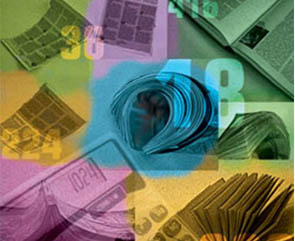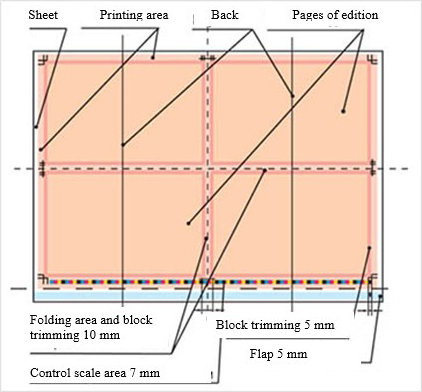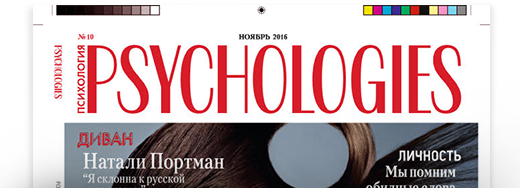HOW MANY PAGES THERE ARE IN A MAGAZINE
For those who decided to release their own edition, it will be useful to learn about some of the rules in force in the publishing and printing industry. When deciding on the number of pages in the edition, it is necessary to take into account some of the technological aspects of the production.
In this article, we will not deal with the calculation of pages for exclusive limited editions with completely or partially manual manufacturing operations. In this case, any number of pages may be, if it is not contrary to the rules.
Let us consider the general cases when it is necessary to produce typical printed materials, where the production is to be technologically advanced. Correctly chosen number of edition pages is important. This parameter affects the time and cost of circulation production.

WHAT WE NEED TO KNOW TO CALCULATE THE NUMBER OF PAGES CORRECTLY.
CIRCULATIONIt is necessary for the correct selection of the printing press. It is profitable to print small circulations up to 5–7 thous. copies on the offset sheet-fed presses, the circulations of more than 10 thous. copies – on the web-fed presses. It is advisable to print very large circulations, about a million copies, on gravure printing presses. |
|
EDITION FORMATIt is necessary for the correct selection of the printing press. It is profitable to print small circulations up to 5–7 thous. copies on the offset sheet-fed presses, the circulations of more than 10 thous. copies – on the web-fed presses. It is advisable to print very large circulations, about a million copies, on gravure printing presses. |
|
MAXIMUM AND MINIMUM FORMAT OF THE SHEET-FED PRESS OR THE WIDTH OF PAPER ROLL AND THE SIZE OF WEB-FED PRESS CUT-OFFThe edition format and the size of the sealed material determine the number of pages that will fit in the printed sheet or in the signature. |
|
CAPABILITIES OF STITCHING TECHNIQUEFor example, the number of the supplying feeders. This parameter defines the maximum possible number of the signatures in the block which can be picked up at a single raising. The optimal is the number of the signatures in the block that does not exceed the number of the feeders of the bookbinding machine. Otherwise, it is likely that manual operations will be required, and this requires additional time and money, or the production technology will be more complicated, which also requires additional expense. |
|
FOLDING LAYOUT(* The magazine “Format”, for example, is printed with 1/12 volume of the 72x104 cm sheet, and not the usual 1/8 or 1/16. Folding turns out to be complex, which caused technical difficulties on the folding machine in some printing houses (at sheet-fed printing) or on the folder of the printing press (at web-fed printing). It is necessary not only to place all edition pages on the paper sheet, but also to make sure that this sheet can be converted into the desired signature. |
These parameters allow to choose the technological scheme of the edition production and, proceeding from this, to determine the volume of the signatures and possible options of the block composition, and hence understand how many pages will be in the ready edition.
THE RULES OF CLACULATION OF PAGES
|
|
Empty page is equal and is treated as any other page of edition. Usually, empty pages are added to some specialized editions (e.g., manuals or guidelines) in order to ensure the start of heads with certain pages: in the technical documentation, there is a rule to start each chapter with the right-hand page. |
|
|
Empty page in serial editions (books, catalogs) are undesirable, and in some cases they are even unacceptable (periodicals). Or, an empty page can be made, but how to justify its presence? It requires some costs (and, as a rule, the same as the filled page), in addition, its presence in the magazine will be perceived by the reader as a defect. Therefore, to supplement the edition volume to the nearest multiple number with empty pages is meaningless. If, however, a few empty pages are formed in the edition, the publishers put their own advertisements, coupons, subscription, etc . (in the extreme case, the traditional sheet “notes”). |
|
|
The number of pages in the edition is always an even number. An odd number is impossible. |
|
|
The minimum number of pages in one signature with glued perfect binding (GPB) is two, and at stitching with wire or thread – it is four. When stitching with the threads, the signatures that are very different in thickness are undesirable. |
For example, if the entire block is folded from the 32-page signatures and it is necessary to add a 4-page signature, then this option should not be considered successful, because this will greatly affect the stitching strength and the block will get “loose”. In this case, it is necessary either to get rid of the four extra pages or to add at least the same number.
As a rule, in major publishing houses, there are well-established technological schemes of editions production, depending on the size and format, which take into account all of the above parameters and the possibility of their own equipment. In this case, you are likely to be offered to use one of the most suitable schemes. Though there are companies that accept editions of any size and format, regardless as to what extent the production of the order can be optimized. The cost is paid by the customer anyway. This is one reason why in various printing houses the cost of production of the same edition may be very different.
Thus, after taking into account all the requirements described above, one can start counting the number of pages. To do this, add the number of pages in full and fractional signatures included in the edition block. Read below about difficulties that may occur.
Thus, we do not advise to take up the calculation of the number of pages independently, without the participation of a technologist of the printing house, wh ere printing of edition is planned.
GLOSSARY
A page is the page of an edition. The edition sheet is a sheet of a magazine or a book and contains two pages.
A signature is a folded printed sheet (not to be confused with the edition sheet), previously trimmed and cut off to bleed size.
A block is a set of selected in a specific order and bound signatures and/or separate sheets, which contains all edition elements except for the cover.
SIMPLE CALCULATIONS
Printing is an old science, and there are many well-established traditions. If we talk about the periodicals, the number of pages and the format of such editions have long been identified by experts. The formats of editions depend on the format of paper sheets (for sheet printing), blanket width and cut-off length (for web printing). At the same time, which is typical, the term “A4 format magazine” is not really correct.
In fact, making the magazine of A4 format (210x297 mm) is technologically unfeasible, and in some cases it is impossible. It is more convenient to use the format “about A4”, which is a bit shorter and wider, reminds the US Letter size and ranges from 215х285 to 220х290 mm.
When choosing the number of pages, one should be guided by a simple rule. If the number of pages in the edition is a multiple of eight, chances are it will not cause any problems in production (up to a certain, large numbers of pages). In any case, the number of pages may be a multiple of four. But here, as with any even number of pages, there is a lot of danger, so it is best to consult a technologist of the printing house.

SHEET FORMAT AND EDITION FORMAT: WHAT THE SHEET AREA IS SPENT FOR?
It turned out that the area of a sheet of paper on which it is intended to print the edition, is not completely spent on self-edition. The paper is partly spent on the technological needs. The figure below shows a sheet of paper (or a sheet of the sheet-fed press, or any part of the paper web after printing on the web-fed press and cut-off) with the technological margins and elements located on it.
PRINTED SHEET DIAGRAM WITH LOCATED NECESSARY ADDITIONAL ELEMENTS: ALLOWANCES, FLAPS, SCALES, ETC.
PLEASE NOTE
Printing area (margin) is always less than the size of the printed sheet. There should be at least 2–3 mm on each side of the paper. It is highly undesirable that the ink is applied directly at the edge of the sheet or, even worse, that the printing area is larger than the sheet area.
In turn, the area, on which the edition pages are placed with an allowance on the block trimming during stitching, is slightly less than the print margins. The register crosses, the cutting and folding marks are located in this margin. Sometimes they can be completely “hidden” in the block trimming area, but they usually “do not fit” there. Thus, the edition print margins are 2–5 mm smaller than the printing edges.
The allowances of the block trimming further reduce the useful area of the sheet. This usually takes 4-5 mm on three sides of each page. In some cases, such as the signatures with “a flap”, this edge can be increased up to 15 mm "in the tail of" the signature.
In addition, it is necessary to provide a special edge in which there will be the grippers transmitting the sheet, in order to ensure that the printing press can transmit the sheet from section to section. This edge is referred to as “a setback” and it will take more 7 to 15 mm (depending on the printing press). Do not confuse this setback with the signature flap. It is important that the setback edge is also present in the web-fed press, although there are no sheets, there is the paper web which moves. The presence of this edge is due to the peculiarities of printing presses design and the mechanism of printing forms fastening. The setback in the web-fed printing can be quite large. Though in some presses it may not be available at all, but such presses are rare.
The edge for placing the control scale also takes up the space on the sheet. The page of about 7–10 mm takes up the full length of the sheet.
IT IS FAR FROM SIMPLE TO CALCULATE THE EDITION FORMAT INDEPENDENTLY, IT IS BETTER TO CONSULT THE SPECIALISTS
“A publisher N asked the printing house P to consider the possibility of printing a book. Soon an official reply came with the options of composition of the future edition: 373 pages is not possible, there can be 368 pages (23 signatures 16 pages) or 384 pages (24 signatures 16 pages), and it is under the condition that the edition format will change to 218х285 mm. The length of cut-off set in the printing house on the web-fed press is 590 mm, thus, the size of 290 mm cannot be made - the scales of printing operational control and the allowances for trimming of the block do not fit either. There was a lively discussion, and at last, in a month, the two parties reached the following agreement: the block will contain 376 pages (23 signatures 16 pages and one signature of eight pages - it is printed as two-up, followed by slitting). On the resulting empty pages, it was decided to place advertising of the publishing company and firms of the deceased.
The edition format had to be once more adjusted to 215х285 mm, as only the roll paper 880 mm wide was available.
IN ADDITION TO THE JOURNAL PAGES, THERE ARE ON THE SHEET AUXILIARY ELEMENTS FOR CONTROL OF PRINTING (SCALES, CROSSES, ETC.), AS WELL AS THE MARKS FOR TRIMMING OF THE READY EDITION (ON THE LEFT). THE PAPER SHEET SEALED ON TWO SIDES, AFTER DOUBLE FOLDING TURNS INTO AN 8-PAGE SIGNATURE (ON THE RIGHT).

In addition, it became clear that the existing perfect binding machine has 20 feeders, and there were 24 signatures in the block, thus, more selection and manual laying were needed, which dramatically increased the labor costs and, as a consequence, the price of the edition. When the client learned about the next price change, he solved the problem radically, by reducing the circulation up to 1500 copies and threatened to “trouble” if he would not receive the order in two weeks. The publisher “understood” and quickly returned to his friend M. His friend also understood the situation and accepted the order.
FINALLY, AFTER ALL ALTERNATIONS, THE EDITION GOT THE FOLLOWING PARAMETERS (FOR SHEET-FED PRESSES)
Block 370 pages (23 three-fold signatures of 16 pages and a two-page insert)
Edition format – 220х290 mm (obtained from the 620х940 mm sheet paper). A small increase in format allowed “to drive in” the extra three pages
Manual composition and adhesive perfect binding on the semi-automatic press with manual loading
Overall, not bad, and the deadline was met. Here is a cautionary tale. The conclusion from it: the edition format and the number of pages in it can be correctly determined only with the technologist of the printing house.

THE “AMERICAN” METHOD OF CALCULATING THE NUMBER OF PAGES
In the advanced economies, for many years the number of pages in periodicals has been determine, strictly on the basis of “the acceptable amount of advertising in the edition”. In our country, the edition is considered to be advertising, if the proportion of paid advertisements exceeds 40%. The remaining 60% must be occupied by author’s and editorial content. In most developed countries, the ratios are similar, so promoted editions abroad apply a simple method of calculating the pages. For example, X advertising pages were collected in the magazine. Hence, the number of author’s material pages should make at least 1.5X. A total number of pages is not less than 2.5X. Further, the number shall be rounded to the nearest 8-page (usually) signature. The edition will contain the resulting number of pages. This method is considered the best for revenues/costs ratio. It is used by many domestic “glossy” magazines, especially those with “international roots”.
